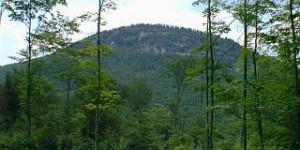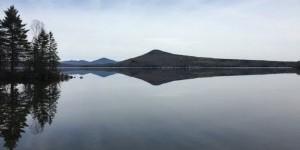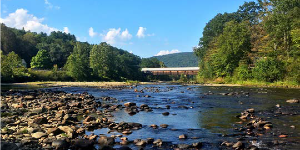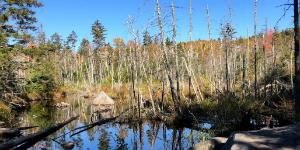Natural resource restoration projects restore ecological functions of natural infrastructure. Forests, lakes, ponds, rivers, floodplains, and wetlands are all examples of natural infrastructure that provide continuing benefits to us socially and ecologically. Natural resources restoration projects help to prevent and reduce nutrient and sediment pollution, improve flood resiliency by mitigating flood hazards, enhance habitat function, and support Vermont’s outdoor recreational opportunities.
Forests provide wood for us to use and wildlife habitat for a diversity of species. Forest ecosystems have intrinsic value: trees purify our air, soil, and water; provide temperature regulation from shading and wind protection. Forests remove excess carbon dioxide from the air and store it above and below ground. Forests also are integral to water quality and affect three levels of watershed function and health: Canopy, forest floor, and soil.
The Department of Forest, Parks and Recreation (FPR) provides support and funding assistance for Acceptable Management Practices (AMPs) to protect water quality during logging operations on forest roads. The skidder bridge rental program is an example of how FPR promotes and provides assistance for AMPs. This controls non-point source pollution associated with timber harvesting regulations.
Lakes and Ponds are the source of much of our drinking water. They also function as catchments for sediment, retain and assimilate phosphorus and prevent nutrient transport. However, an excess of nutrients and sediment loading can negatively impact the water quality and require regulation in order to protect this natural resource. Lakes and Ponds are excellent providers of recreational activities and educational opportunities that connect people with the outdoors.
The Lakes and Ponds Program implements regulatory practices to protect Vermont’s shorelands. The Shorelands Protection Act seeks to balance good shoreland management and development. The Lake Wise Program aims to reduce water quality impacts of shoreland development by offering technical assistance for lakeshore owners to maintain their properties.
Rivers and their Floodplains maintain water quality by dissipating energy during storms in order to lessen the erosive force of streams and rivers. A river that has access to its floodplain can promote groundwater exchange, accommodate movement of dynamic river courses, and minimize fluvial erosion.
The Rivers Program protects and restores natural river and floodplain processes to enhance water quality, ecological health, and flood resilience. The program partners with municipalities to support floodplain conservation projects and offer technical assistance on river corridor and floodplain bylaws, as well as stream geomorphic assessments.
Wetlands are like the kidneys of the ecosystem. They improve water quality by filtering nutrients, pollutants (such as heavy metals), and excess sediment that have been deposited into the system. Wetlands also decrease the flashiness of rivers during storms by temporarily storing flood waters and allowing water to slowly infiltrate back into the system. The degree to which a wetland serves these functions depends on the hydrology, soil, vegetation, size, and location of the wetland in the landscape.
The Wetlands Program identifies and protects wetlands and the functions and values they provide by the implementation of the Vermont Wetlands Rules.




